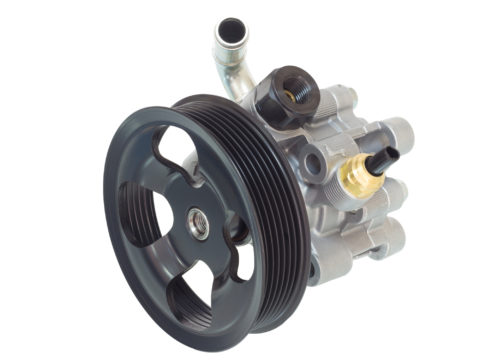A problem with your car’s steering wheel is a pretty big deal. When the steering wheel is hard to turn, you need to get to the bottom of the issue right away. Otherwise, you might risk a situation where you can’t maneuver your car and wind up in an accident.
So, let’s look at steering wheel problems, their causes, and how to fix them.

A car’s steering wheel controls your vehicle’s direction of travel. Modern cars have systems like power steering pumps or electronic servos that assist the driver in turning the wheel. Sometimes, when these systems have an issue, the first sign of problems will be a steering wheel that’s not as easy to turn as you’d expect.
So, if it’s hard to turn your car’s steering wheel, something is wrong. It’s a good idea to troubleshoot the problem before you find yourself in a potentially unsafe situation.
When the steering wheel gets hard to turn, it means you need to increase your effort to point the car’s wheels where you need them. That is often a sign of a problem with one of the car’s underlying mechanical systems.
Contents
Common Hard Steering Wheel Scenarios
Thankfully, because of the configuration of the steering systems on modern cars, it’s often fairly easy to zero in on the source of common steering wheel problems. It’s not always easy to fix the issue, but you can start determining the likely cause right away and without even opening the hood.
Steering Wheel Hard to Turn When Not Moving
If your car’s steering wheel is hard to turn when your vehicle is stationary, you could have any one of a number of issues. The first thing to check is the simplest…does your car have a flat tire or one that’s really low on air pressure? Without enough air to hold up the weight of your car, a flat or low tire can make it hard to turn the wheel.
Steering Wheel Hard to Turn When Car Starts
Sometimes, when your car has just started, it might feel hard to turn the wheel because the systems haven’t come all the way up to speed yet.
Steering Wheel Hard to Turn at Low Speeds
When you’re driving slowly, it takes more effort to turn the wheel than when you’re moving faster. So, if some portion of the steering wheel’s booster system isn’t working right, it might be harder to turn the wheel than you would expect.
Hard to Turn Steering Wheel in Reverse
When you’re in reverse gear, you’re usually moving pretty slowly, so any problems with the steering wheel will be fairly noticeable.
Steering Wheel Hard to Turn When AC Is On
The turning of the engine usually powers the AC system on a car. Since the engine is also often responsible for turning your power steering pump, any issue with either system might manifest in a situation where it’s hard to turn the wheel while the air conditioner is running.
Steering Wheel Hard to Turn When It’s Cold
When it’s cold out, things don’t always work as smoothly as they might in warm weather or after the car has had a chance to get to full operating temperature. If you have an issue with the steering wheel being hard to turn when it’s cold, let things warm up a bit and see if anything changes.
Steering Wheel Hard to Turn on One Side
If you have to work really hard to turn the steering wheel to one side only, it might help you diagnose the issue. You might have a problem with a tire, a wheel, or even a piece of the suspension on one side of the car.
Steering Wheel Hard to Turn After Replacing Rack and Pinion
If you just had major maintenance performed on your car, and you have a new rack and pinion, it’s possible that your system still needs a little bit of maintenance. It might be something as simple as just needing more lubrication or a top-up on the fluid for your power steering reservoir.
Hard to Turn Steering Wheel When Braking
Sometimes, when your car moves dynamically or aggressively, and you’re braking while turning, it may become hard to turn the wheel, even when everything is working right. But those situations should be few and far between and occur only when you’re losing traction.
What Causes Hard Steering Problems?
There are quite a few reasons why it may be difficult to turn your steering wheel. Let’s look at some of the most common reasons.
Power Steering Fluid Low
If the power steering system is low on fluid, turning your steering wheel may be difficult or sluggish. That’s because the fluid in the system isn’t making enough pressure to assist you in turning the wheel.
Power Steering Belt Loose
If the power steering system’s belt is loose, the pump won’t turn properly. That will result in diminished assistance, and eventually, the power steering will fail when the belt either slips off or breaks entirely.
Even though power steering belts are pretty tough, even the best ones break down over time and eventually need replacement.
Power Steering Pump Failure
When a power steering pump starts to fail, you may hear a squealing sound from under the hood when you turn the wheel. You’ll also probably notice that it’s getting harder to turn the wheel. Sometimes the pump will fail gradually. Other times it will just stop working all at once.
Broken Steering Rack
Many cars feature a rack and pinion steering system. When the rack starts to fail, you’ll probably notice that it’s hard to turn the steering wheel right when you start the car. Then, as you drive a bit and things warm up, the steering assistance improves. That’s because a damaged rack tends to work better at operating temperature.
The next time the car sits idle for a couple of hours, and you start it back up, the problem will return.
Broken Tie Rod or Flat Tire
Sometimes the problem isn’t even related to the steering system itself. Instead, it’s hard to turn the wheel because there is a problem with the tire, wheel, or suspension. If the tire isn’t holding the car up enough, the weight of the car will make it hard to turn the wheel. The same thing will happen if you have a broken wheel or a damaged suspension component that’s tied into the wheels.

How to Fix the Hard Steering Problem
Steering wheel problems can be very frustrating and even dangerous. The good news is that it’s sometimes really easy to fix the issue.
Check Air Pressure
Periodically, every driver should be checking their car’s tire pressure. It’s really easy to do, and it can help prevent steering issues and premature tire wear. Get yourself a tire gauge and unscrew the valve stem cap on one tire. Press the gauge to the stem and check your reading.
Compare the reading to the manufacturer’s recommended tire pressure. You can usually find that information in the owner’s manual or sometimes inside the fuel tank door. Add air from a pump as needed. Work your way around the car and perform the same maintenance on each tire. Make sure to screw your valve stem caps back into place when you’re done.
Fill Your Power Steering Fluid Reservoir
The power steering pump’s reservoir is under the hood near your engine. It has markings on the side of it to show you the right level for the fluid. Check your owner’s manual and make sure you have the right type of fluid on hand.
Then, unscrew the cap on the reservoir and fill it to the indicated operating level. Make sure to screw the cap back on tightly, as the system is pressurized and can easily leak without a tight seal.
Inspect the Power Steering Belt
Make sure your engine is off, and look at the belts running around the engine. There might be one long one running between a few pumps. That’s called a serpentine belt. Or, there might be a series of smaller belts that go to different pumps. If it seems like the belt is undamaged, consider spraying it with a commercial power steering belt lubricant.
Replace the Power Steering Belt
If you see signs of wear when you inspect the power steering belt, you should have it replaced by a mechanic. You might even be able to do it yourself. The most common sign of a wearing belt is one that is frayed at the edges. Other times, it may look like it’s ripping or otherwise damaged.
Bring Your Car to a Pro
If you have a larger steering issue, like a bad steering pump, failing electric servos, or a broken steering rack, you’re probably going to need a mechanic to repair it. This can be expensive, but it will be worth it to ensure everything is taken care of properly.
How Much Does It Cost to Fix a Stiff Steering Wheel?
Fixing a stiff steering wheel doesn’t always cost much money. If you’re lucky, you might only have to recondition the belt. Or, if you just have a small leak in the power steering system, there are additives you can add to the reservoir that can plug up the leak automatically and restore normal operation.
If you have a bigger issue, it can cost a few hundred to a thousand dollars to fix a steering wheel that’s hard to turn.














